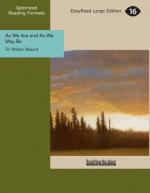Or, which is another method, he may consider the City with regard to certain divisions of subjects. He may make, for instance, a special study of the London churches. The City, small as it is, formerly contained nearly 150 parishes, each with its church, its burying-ground, and its parish charities. Some of these were not rebuilt after the Great Fire, some have been wickedly and wantonly destroyed in these latter days. A few yet survive which were not burned down in that great calamity. These are St. Helen and St. Ethelburga; St. Katherine Cree, the last expiring effort of Gothic, consecrated by Archbishop Laud; All Hallows, Barking, and St. Giles. Most of the existing City churches were built by Wren, as you know. I think I have seen them nearly all, and in every one, however externally unpromising, I have found something curious, Interesting, and unexpected—some wealth of wood-carving, some relic of the past snatched from the names, some monument, some association with the medieval city.
Of course, it is well to visit these churches on the Saturday afternoon or Monday morning, when they are swept before and after the service; but as one is never quite certain of finding them open, it is, perhaps, best to take them after service on the Sunday. If you show a real interest in the church, you will find the pew-opener or verger pleased to let you see everything, not only the monuments and the carvings in the church, but also the treasures of the vestry, in which are preserved many interesting things—old maps, portraits, old deeds and gifts, old charities—now all clean swept away by the Charity Commission—ancient Bibles and Prayer-books, muniment chests, embroidered palls, old registers with signatures historical—all these things are found in the vestry of the City church.
Then there are the churchyards. We are familiar with the little oblong area open to the street, surrounded by tall warehouses, one tomb left in the middle, and three headstones ranged against the wall, patches of green mould to represent grass, and a litter of scraps of paper and orange-peel. This is fondly believed to be the churchyard of some old church burned down or rebuilt. There are dozens of these in the City; it is sometimes difficult to find out the name of the church to which they once belonged. Every time a building is erected adjacent to them they become smaller, and when they happened to lie behind the houses they were shut in and forgotten, covered over and built upon when nobody was looking, and so their very memory perished.
It is curious to look for them. For instance, there is a certain great burying ground laid down in Strype’s map of the year 1720. It is there represented as so large that to cover it up would be a big thing. No single man would dare to appropriate all at once so huge a slice of land. I went, therefore, in search of this particular churchyard, and I found a very curious thing. On one side




